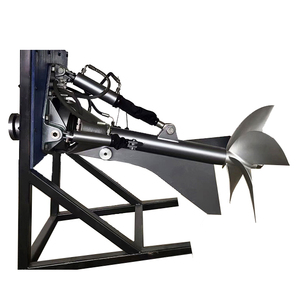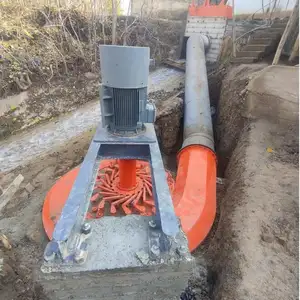
All categories
Featured selections
Trade Assurance
Buyer Central
Help Center
Get the app
Become a supplier

(1553 products available)


































Marine jet propulsion is a powerful technology used to drive ships and boats. It uses a jet of water ejected from the engine to create thrust. This propulsion system offers efficient and high-speed performance, making it popular for various marine applications. There are different types of marine jet propulsion systems, each designed to suit specific needs and preferences.
Water Turbines
Water turbines are used in large jets and naval vessels. They are designed to handle substantial water volumes, providing efficient propulsion even at high speeds. The axial flow of these turbines generates a powerful jet of water, pushing the vessel forward. The design minimizes cavitation and ensures reliable performance under various operating conditions.
Axial Flow Pumps
Axial flow pumps are one more option for marine jet propulsion systems. These pumps use impellers to create a continuous flow of water along the axial direction. They are known for their low-pressure drop and high flow rates, making them suitable for applications requiring steady and reliable propulsion. Axial flow pumps are often used in smaller jets and recreational vessels, offering efficient performance with lower operating costs.
Mixed Flow Pumps
Mixed flow pumps combine axial and radial flow elements to provide versatile propulsion solutions. They are designed to handle varying water depths and flow conditions, making them suitable for inland and deep-sea applications. Mixed flow pumps generate a powerful jet of water, ensuring efficient propulsion and maneuverability. Their adaptability and reliability make them a preferred choice for cargo ships, fishing boats, and passenger ferries.
Radial Flow Pumps
Radial flow pumps are designed for high-pressure applications in marine jet propulsion systems. They use impellers to generate radial flow, creating a powerful jet of water with high velocity and pressure. This allows for precise control and maneuverability, making radial flow pumps suitable for military vessels, research ships, and other applications requiring high performance and reliability. However, radial flow pumps require more maintenance and careful operation to ensure optimal performance.
Jet Drive
Jet drive systems are commonly used in small to medium-sized vessels, such as pleasure crafts and commercial ferries. These systems use water jets to provide thrust and steering control, offering high-speed performance and excellent maneuverability. Jet drive systems are often equipped with variable nozzles and integrated steering systems, allowing for precise control and responsiveness. They are suitable for various marine applications, including racing, leisure, and commercial transport.
Marine jet propulsion systems are a vital technology for a variety of watercraft, offering efficient and reliable means of propulsion. Understanding their specifications and conducting regular maintenance is crucial for optimal performance. Here is a comprehensive guide:
Power: Marine jet engines vary in horsepower, from small jets with a few hundred horsepower to large ones with several thousand horsepower. This allows for a range of vessel sizes and performance levels. Thrust: The amount of force generated by the jet to propel the vessel forward is measured in pounds or kilograms. Thrust is a critical factor in determining a vessel's speed and acceleration. Jet Size: The diameter of the nozzle through which the water is expelled. Larger nozzles can produce more thrust but may reduce fuel efficiency. Jet size is often matched to the engine's horsepower to optimize performance. Intake Size: The size of the inlet through which water is drawn into the jet system. Larger intakes can improve efficiency and performance but must be appropriately sized for the vessel's hull. Impeller Diameter: The impeller is a rotating component inside the jet that pushes water through the system. Impeller diameter affects thrust and efficiency, with larger impellers generating more power but requiring more energy. Pump Pressure: The pressure at which water is expelled from the nozzle. Higher pump pressure can increase thrust but may lead to increased fuel consumption. Material: Marine jets are typically constructed from aluminum, stainless steel, or other corrosion-resistant materials. The choice of material impacts the jet's durability, maintenance requirements, and overall performance.
Regular maintenance is essential to keep marine jet engines in good working order and maximize performance. Some critical maintenance tasks include:
Choosing the right marine jet engine for a specific application involves considering various factors to ensure optimal performance, efficiency, and reliability. Here are some key factors to consider:
By carefully considering these factors, buyers can choose a marine jet engine that meets their needs, optimizes performance, and ensures reliability and efficiency in marine propulsion.
Below are the basic steps for maintaining and replacing parts of the marine jet propulsion system.
Water Intake Screens
Check the water intake screens for debris. If there is any, remove it. Screen replacement is easy and doesn't require special tools.
Oil Filters and Oil Changes
Change the oil every 50-100 hours of use or at least once a year. The oil change interval might differ based on the engine type. Use an oil filter wrench to remove the old filter. Then, install the new filter after coating its rubber ring with a little clean oil. Pour fresh oil into the engine per the owner's manual instructions. Run the engine for a few minutes. Then, check the oil level again and add more oil if necessary.
Cooling System
Inspect the cooling system for leaks. If there are any, tighten the loose clamps. Replace damaged hoses and check the water pump impeller every 200 hours.
Jet Unit
Check the oil level in the jet unit gearbox. Top up with the recommended gear oil if it is low. Change the jet unit oil once every 200 hours of operation.
Throttle and Steering Cables
Adjust the throttle and steering cables if they are loose. Lubricate them with a little marine grease to keep them moving smoothly.
Propulsion Nozzles
Check the nozzles for cracks or wear and replace them if damaged. Adjust the nozzle alignment to ensure the jet flow is straight.
Air Filters
Check the air filters and clean them. Replace them if they are too worn out. The air filter replacement interval depends on how often one uses the jet.
These simple checks and changes can help keep the marine jet propulsion system running smoothly. However, refer to the manufacturer's guide for specific maintenance timelines and procedures.
Q1: What is a marine jet propulsion system?
A1: A marine jet propulsion system is a technology used to propel watercraft by converting the engine's mechanical power into kinetic energy in the water. The system draws water from the surrounding environment, accelerates it through an impeller or rotor, and then expels it through a nozzle, creating a jet of water that generates thrust and moves the vessel in the desired direction.
Q2: What are the components of a marine jet propulsion system?
A2: A marine jet propulsion system consists of several key components: - Inlet: Water is drawn into the system through the inlet from the surrounding environment. - Impeller/Rotor: The engine drives the impeller or rotor, which accelerates the water. This component is crucial for converting the engine's mechanical power into kinetic energy in the water. - Diffuser: The water flows through the diffuser, where its pressure increases while its velocity decreases. - Nozzle: The nozzle accelerates the water jet, converting pressure energy into kinetic energy, and expels the jet of water to generate thrust. - Steering System: Some marine jet propulsion systems include a steering system that directs the water jet, allowing the vessel to maneuver and change direction.
Q3: What are the advantages of marine jet propulsion over traditional propeller systems?
A3: Marine jet propulsion systems offer several advantages compared to traditional propeller systems: - Shallow Water Operation: Jets allow vessels to operate in shallow waters without the risk of damage or grounding, as there are no exposed propeller blades. - Higher Speeds: Jet-propelled vessels can achieve higher speeds and accelerate more quickly due to the efficient conversion of engine power into thrust.
- Maneuverability: Marine jet propulsion systems provide better maneuverability, especially at low speeds, as the water jet can be directed for precise control.
- Reduced Cavitation: Jets experience less cavitation, resulting in improved efficiency and reduced damage to the propulsion system.
- Lower Noise and Vibration Levels: Jet propulsion systems generally produce less noise and vibration compared to traditional propeller systems, providing a smoother and quieter operation.
Q4: What types of vessels commonly use marine jet propulsion systems?
A4: Marine jet propulsion systems are employed in various types of watercraft, particularly those requiring high performance, maneuverability, and shallow water capabilities. These include: - High-speed ferries and passenger vessels for fast and efficient transport of passengers. - Workboats and service vessels used for various tasks, including offshore support, research, and environmental monitoring. - Military vessels and patrol boats designed for naval operations, surveillance, and maritime security. - Leisure and sports boats, such as yachts and racing vessels, where performance and luxury are paramount.
Q5: What maintenance is required for marine jet propulsion systems?
A5: To ensure optimal performance and longevity of marine jet propulsion systems, regular maintenance and care are essential. Key maintenance tasks include: - Routine inspections for wear, damage, or corrosion in all components, including inlets, impellers, and nozzles. - Regular cleaning of the inlet and other components to prevent debris buildup and maintain optimal water flow. - Checking and replacing seals, gaskets, and O-rings as needed to prevent leaks and maintain system integrity. - Monitoring and maintaining proper lubrication for moving parts, such as bearings and the impeller shaft. - Regularly inspecting and maintaining the engine and associated systems (e.g., fuel, exhaust) to ensure efficient operation of the jet propulsion system.